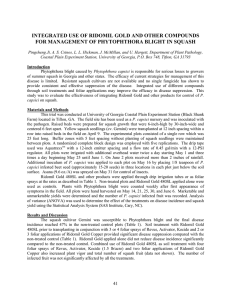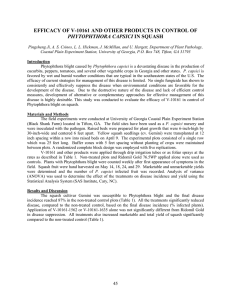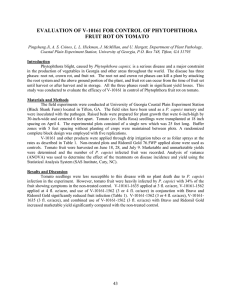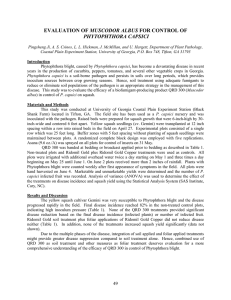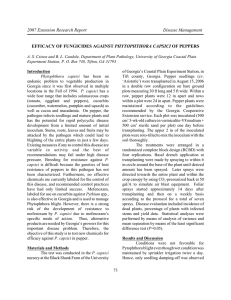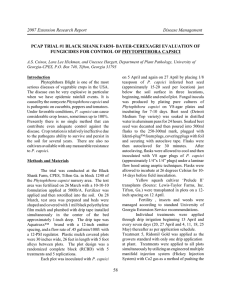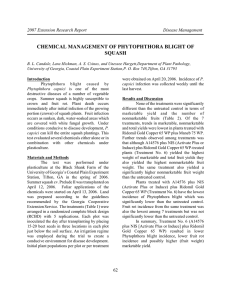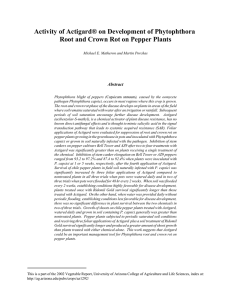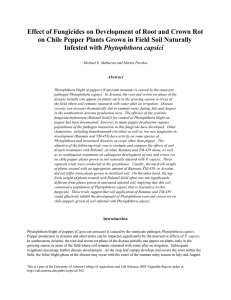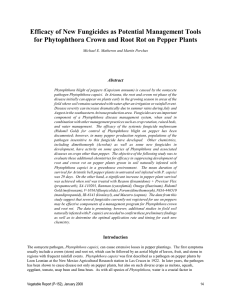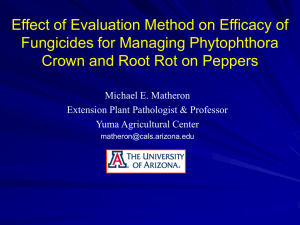EVALUATION OF REVUS AND OTHER COMPOUNDS FOR
advertisement
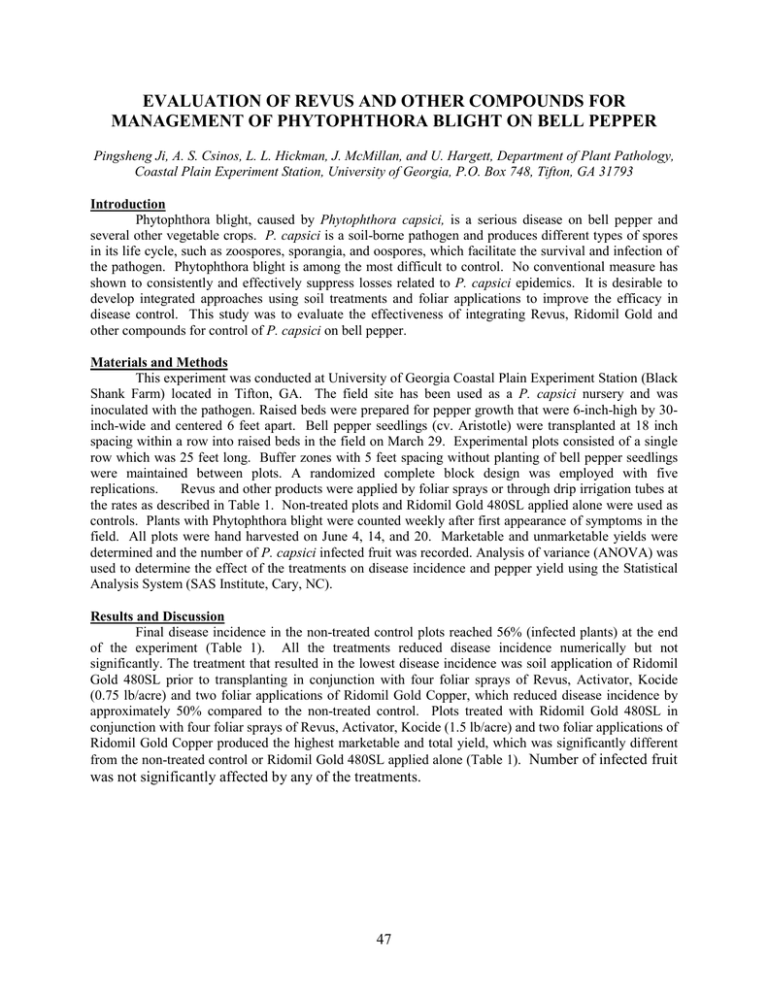
EVALUATION OF REVUS AND OTHER COMPOUNDS FOR MANAGEMENT OF PHYTOPHTHORA BLIGHT ON BELL PEPPER Pingsheng Ji, A. S. Csinos, L. L. Hickman, J. McMillan, and U. Hargett, Department of Plant Pathology, Coastal Plain Experiment Station, University of Georgia, P.O. Box 748, Tifton, GA 31793 Introduction Phytophthora blight, caused by Phytophthora capsici, is a serious disease on bell pepper and several other vegetable crops. P. capsici is a soil-borne pathogen and produces different types of spores in its life cycle, such as zoospores, sporangia, and oospores, which facilitate the survival and infection of the pathogen. Phytophthora blight is among the most difficult to control. No conventional measure has shown to consistently and effectively suppress losses related to P. capsici epidemics. It is desirable to develop integrated approaches using soil treatments and foliar applications to improve the efficacy in disease control. This study was to evaluate the effectiveness of integrating Revus, Ridomil Gold and other compounds for control of P. capsici on bell pepper. Materials and Methods This experiment was conducted at University of Georgia Coastal Plain Experiment Station (Black Shank Farm) located in Tifton, GA. The field site has been used as a P. capsici nursery and was inoculated with the pathogen. Raised beds were prepared for pepper growth that were 6-inch-high by 30inch-wide and centered 6 feet apart. Bell pepper seedlings (cv. Aristotle) were transplanted at 18 inch spacing within a row into raised beds in the field on March 29. Experimental plots consisted of a single row which was 25 feet long. Buffer zones with 5 feet spacing without planting of bell pepper seedlings were maintained between plots. A randomized complete block design was employed with five replications. Revus and other products were applied by foliar sprays or through drip irrigation tubes at the rates as described in Table 1. Non-treated plots and Ridomil Gold 480SL applied alone were used as controls. Plants with Phytophthora blight were counted weekly after first appearance of symptoms in the field. All plots were hand harvested on June 4, 14, and 20. Marketable and unmarketable yields were determined and the number of P. capsici infected fruit was recorded. Analysis of variance (ANOVA) was used to determine the effect of the treatments on disease incidence and pepper yield using the Statistical Analysis System (SAS Institute, Cary, NC). Results and Discussion Final disease incidence in the non-treated control plots reached 56% (infected plants) at the end of the experiment (Table 1). All the treatments reduced disease incidence numerically but not significantly. The treatment that resulted in the lowest disease incidence was soil application of Ridomil Gold 480SL prior to transplanting in conjunction with four foliar sprays of Revus, Activator, Kocide (0.75 lb/acre) and two foliar applications of Ridomil Gold Copper, which reduced disease incidence by approximately 50% compared to the non-treated control. Plots treated with Ridomil Gold 480SL in conjunction with four foliar sprays of Revus, Activator, Kocide (1.5 lb/acre) and two foliar applications of Ridomil Gold Copper produced the highest marketable and total yield, which was significantly different from the non-treated control or Ridomil Gold 480SL applied alone (Table 1). Number of infected fruit was not significantly affected by any of the treatments. 47 Table 1. Efficacy of Revus and other compounds in control of Phytophthora blight on bell pepper Treatment and rate Non-treated control Ridomil Gold 480SL, 16 fl. oz/A REVUS 2.09SC, 8 fl. oz/A Activator 90 Kocide 3000 46.1DF, 1.5 lb/A Ridomil Gold Copper 65WP, 2 lb/A Ridomil Gold 480SL, 16 fl. oz/A REVUS 2.09SC, 8 fl. oz/A Activator 90 Kocide 3000 46.1DF, 0.75 lb/A Ridomil Gold Copper 65WP, 2 lb/A Ridomil Gold 480SL, 16 fl. oz/A REVUS 2.09SC, 8 fl. oz/A Activator 90 Kocide 3000 46.1DF, 1.5 lb/A Ridomil Gold Copper 65WP, 2 lb/A Ridomil Gold 480SL, 16 fl. oz/A REVUS 2.09SC, 8 fl. oz/A Activator 90 Ridomil Gold Copper 65WP, 2 lb/A Ridomil Gold 480SL, 16 fl. oz/A Application schedule1 Yield (lb/A)2 Disease Infected Infected 2,3 fruit plant (%)2,4 1.4 a 56.5 a Marketable Total ---A BCEF BCEF BCEF DG A BCEF BCEF BCEF DG A BDF BDF BDF CEG A BDF BDF CEG 4,835 bc 5,750 bc 9,736 a 10,846 a 1.7 a 35.3 a 5,815 bc 6,991 bc 1.8 a 28.2 a 7,645 ab 8,886 ab 1.9 a 38.8 a 6,338 bc 7,645 abc 2.0 a 34.1 a ABCDEF 3,659 c 4,312 c 1.0 a 44.7 a 1 A = preplant, B = 1 week post transplanting (PP), C = 2 weeks PP, D = 3 weeks PP, E = 4 weeks PP, F = 5 weeks PP, G = 6 weeks PP. 2 Data are means of five replications. Means within a column followed by the same letter are not significantly different (P = 0.05) according to Duncan’s multiple range test. 3 Number of P. capsici infected fruit each plot. 4 Final disease incidence. 48
